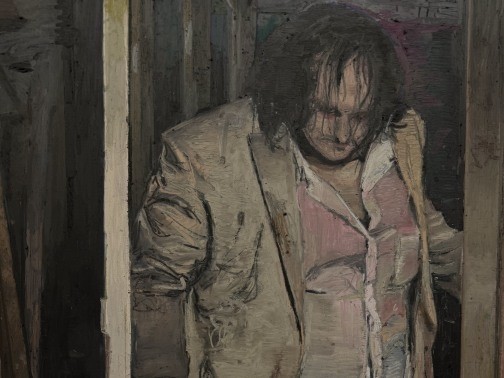
Michelle Uckotter: Moviestar & Cameron
The whole of Michelle Uckotter’s (b. 1992) Moviestar unfolds in three interconnected parts: a solo exhibition at Matthew Brown, a parallel exhibition at Marc Selwyn Fine Art juxtaposed with an exhibition of works by Cameron (1922–1995), curated by Uckotter, and the debut of a short film by the same title directed and co-written by Uckotter and poet Riley Mac.
The paintings in Moviestar, inspired by stills from the film, position the viewer as both witness and accomplice, immersed in Uckotter’s “cinema of painting.” These works, rendered in dusky jewel tones of oil pastel, show a sequence of events—perhaps a night of partying gone very, very wrong, or a Manson-style cult ritual––that devolve into a fever dream of violence and eroticism. These scenes, in both content and sensation, are reminiscent of 1970s B-horror and exploitation films, like the final acts of Russ Meyer’s Beyond the Valley of the Dolls (1970), where surreal Hollywood decadence spirals into the psychedelic carnage of a cast of Playboy Bunnies,or the dinner table scene in Tobe Hooper’s The Texas Chain Saw Massacre (1974), where domesticity is reconfigured as a sadistic ritual. In both of these climaxes, the bodies of the villains and victims shift between states––idolized, violated, consumed––while identities remain in flux. In Moviestar, Uckotter’s figures slip and shift between archetypes in a similar fashion: starlet and sacrifice, predator and prey, their roles never fully fixed.
By modifying stills from her own film to fit the confines of the compositions, Uckotter assumes the role of artist-as-director, orchestrating the viewer’s gaze—but also disrupting the passive consumption of violence.
Removed from their original context, these images resist narrative closure, allowing the tenuous boundaries between violence and pleasure to exist as something sublimely unresolved: the paintings reclaim agency from the cinema of exploitation, and reposition the act of looking as both an indictment and an invitation.
Uckotter’s articulation of the interiors of her paintings is crucial: in contrast to the violence and laborious intensity of her markmaking, her fastidious ability to render architecture allows for the precariousness and sensuality of her scenes to take full effect. The set constructed for Moviestar is, in a way, Uckotter’s own Étant donnés(Marcel Duchamp, 1946–1966). The rigidity of the constructed set contrasts with the painterly, impressionistic fluidity of the image viewed through the “peephole,” in this case her direction of the camera in the film and the viewer’s gaze in the paintings. The scene in one painting easily flows into another based on individual interpretation, asserting focus on the organic disorder of the posed female figures.
These figures, in Uckotter’s paintings and film are more “archetypes” than subjects, styled and posed in ways that interrogate anxieties surrounding unstable bodies and identity, where the boundaries of the feminine exist as sites of both desire and destruction. Like the lustmord painting of the Neue Sachlichkeit painters of Weimar Germany, where scenes of sexual murder represented a desire for agency with shifting gender and societal norms after the ravages of World War I, Uckotter’s figures address the contradictions of how a woman can create herself––or be destroyed––in a world not built for her.
Uckotter’s Moviestar walks the thin, volatile line between agency and objectification, spectacle and destruction. In her world, femininity is unstable, slipping between performance and erasure, violence and becoming. Like the experience of womanhood itself, her scenes resist resolution, caught in the tension between transformation and the structures that seek to contain it. In reanimating the language of exploitation cinema, Uckotter exposes and shatters the frame, but never fully reveals her own role in the production. Like any skilled director, she is everywhere in the scene—yet nowhere to be found.
Moviestar at Matthew Brown opens Thursday, February 13th from 6–8 PM. A screening of the film will take place at Now Instant theater in Chinatown on Monday, February 17th. Please contact abby@marcsewlynfineart.com for more information.
CAMERON, the visionary artist, performer, and sorceress, was a key figure in the avant-garde and occult scenes in Southern California in the 1940s, 50s, and 60s. On view in the adjoining gallery are paintings and drawings by the artist that meld her surrealist self-exploration, psychedelic experiences, astrology, and magical rituals.
Depictions of figures in her life as otherworldly personas frequent her oeuvre, as seen in Sebastian (Imaginary Portrait of Kenneth Anger), 1962, referencing the artist-filmmaker with whom Cameron had a long relationship as friend and artistic collaborator. Cameron lived with Anger and is said to have inspired his occultism. He cast her in a leading role in Inauguration of the Pleasure Dome (1956), his dreamlike portrayal of a ritual initiation inspired by Aleister Crowley’s Gnostic Mass. Writer Michael Duncan details, “Cameron’s romantic aesthetic and commanding presence inspired filmmaker Curtis Harrington to honor her artistic work in The Wormwood Star (1955), a poetic short film capturing the ambiance of her candlelit studio and the beauty of her art.” Harrington cast Cameron again in a significant role in his dreamy feature Night Tide (1961). A painting by Cameron of the same title from 1958 is included in the exhibition.
Cameron’s hand-drawn astrological charts function as another type of mystical portraiture. Included in this show are star charts for her husband Jack Parsons, a celebrated occultist and rocket scientist, Aleister Crowley, founder of the Thelema religion, and actor Marlon Brando.
Her most legendary work, Peyote Vision, 1955, depicting a serpent-tongued woman in a sex act with an alien being, is also displayed. In 1957, an image of the work was incorporated in a Wallace Berman installation at the legendary Ferus Gallery. Deemed "lewd" by the Los Angeles Police Department, the drawing resulted in the temporary closing of the gallery and the arrest of Berman for obscenity. After the incident, Cameron refused to show her art in commercial galleries, further cementing her role as an underground, avant-garde figure.